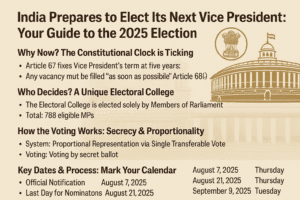India Prepares to Elect Its Next Vice President: Your Guide to the 2025 Election
India will elect its 17th Vice President following a constitutional vacancy, with voting scheduled for September 9, 2025, if required. MPs alone form the electoral college (782 current members), each wielding one equally weighted vote under a secret ballot system. Candidates need nominations from 20 proposers and 20 seconders—all fellow MPs—by August 21, alongside a ₹15,000 deposit.
The election uses proportional representation via single transferable vote, where MPs rank candidates in strict secrecy, with no party whips allowed. Critically, votes must be marked using special pens provided at Parliament’s polling booth to count. The winner will serve a full 5-year term as Rajya Sabha Chair and first-in-line presidential successor. The Election Commission enforces strict anti-bribery rules and eco-friendly procedures throughout. This election ultimately shapes a key guardian of India’s parliamentary democracy and constitutional continuity.

India Prepares to Elect Its Next Vice President: Your Guide to the 2025 Election
The office of India’s Vice President is officially vacant following a notification from the Ministry of Home Affairs on July 22, 2025. Triggering constitutional protocols, the Election Commission of India (ECI) has announced the full schedule for the 17th Vice-Presidential Election. This isn’t just a procedural footnote – it’s a crucial process determining who will hold a key constitutional position, presiding over the Rajya Sabha and stepping into the President’s role if needed. Here’s what you need to know, distilled for clarity and context:
Why Now? The Constitutional Clock is Ticking
- The Vice President’s term is constitutionally fixed at five years (Article 67).
- A vacancy, whether due to resignation, completion of term, or other reasons, must be filled “as soon as possible” (Article 68(2)).
- The newly elected VP will serve a full five-year term.
Who Decides? A Unique Electoral College Unlike the public voting for MPs, the Vice President is elected solely by Members of Parliament:
- The Electoral College: All elected and nominated members of both the Lok Sabha (543 seats, currently 1 vacant) and the Rajya Sabha (233 elected + 12 nominated, currently 5 elected vacant).
- Total Votes: 788 eligible MPs (currently 782 due to vacancies). Crucially, each MP’s vote carries equal weight (value = 1).
How the Voting Works: Secrecy & Proportionality
- System: Proportional Representation via the Single Transferable Vote (STV). This allows MPs to rank candidates in order of preference.
- Secrecy is Paramount: Voting is by secret ballot. Showing your marked ballot to anyone is strictly prohibited and invalidates the vote. Political parties cannot issue whips directing MPs how to vote.
- The Ballot: Voters must mark at least their first preference. Further preferences are optional but can be crucial in determining the winner under STV.
- Special Pen: Votes must be marked using a specific pen provided at the polling station (Room F-101, Parliament House). Using any other pen invalidates the vote.
The Candidates: High Bar for Entry
- Nomination: Requires the support of at least 20 proposers and 20 seconders, all of whom must be MPs. An MP can only support one candidate (as proposer or seconder).
- Filing: Candidates or their proposers/seconders can file up to four nomination papers between 11 AM and 3 PM (excluding holidays) starting August 7th.
- Deposit: A security deposit of ₹15,000 is mandatory.
Key Dates & Process: Mark Your Calendar
| Event | Date | Day |
| Official Notification | August 7, 2025 | Thursday |
| Last Day for Nominations | August 21, 2025 | Thursday |
| Scrutiny of Nominations | August 22, 2025 | Friday |
| Last Day to Withdraw | August 25, 2025 | Monday |
| Polling (if needed) | September 9, 2025 | Tuesday |
| Counting (if needed) | September 9, 2025 | Tuesday |
- Polling Hours: 10:00 AM to 5:00 PM.
- Scrutiny & Withdrawal: Nominations are checked on August 22nd. Candidates can withdraw by August 25th. If only one valid candidate remains after withdrawals, they are declared elected unopposed.
Why This Election Matters Beyond Procedure
- Guardian of the Rajya Sabha: The VP’s primary role is as the impartial Chairman of the Upper House, managing debates and ensuring procedure.
- Constitutional Safety Net: The VP is first in the line of succession to the Presidency.
- Reflection of Political Dynamics: While non-partisan in function, the election outcome often reflects the balance of power within the ruling coalition/alliance and its ability to garner cross-party support among MPs.
- Symbolic Role: The VP represents India at high-level functions and embodies constitutional continuity.
Ensuring Integrity The ECI, led by Returning Officer Rajya Sabha Secretary-General, oversees the process. Observers are appointed, and strict rules against bribery and undue influence (under the Presidential and Vice-Presidential Elections Act, 1952, and Bharatiya Nyay Samhita) are in place. The Commission has also emphasized using eco-friendly materials during the election process.
Where to Learn More The ECI has published an information booklet covering this election and past VP elections (available on the ECI website or for purchase at ₹50 from their office). The official Electoral College list is also available for ₹100.
India’s Vice-Presidential election is a sophisticated exercise in indirect democracy. While the electorate is small (only MPs), the process demands strict adherence to constitutional principles, secrecy, and a unique voting system, ultimately shaping who occupies one of the nation’s highest offices for the next five years. The coming weeks will reveal the candidates and test the political landscape within Parliament’s halls.
You must be logged in to post a comment.